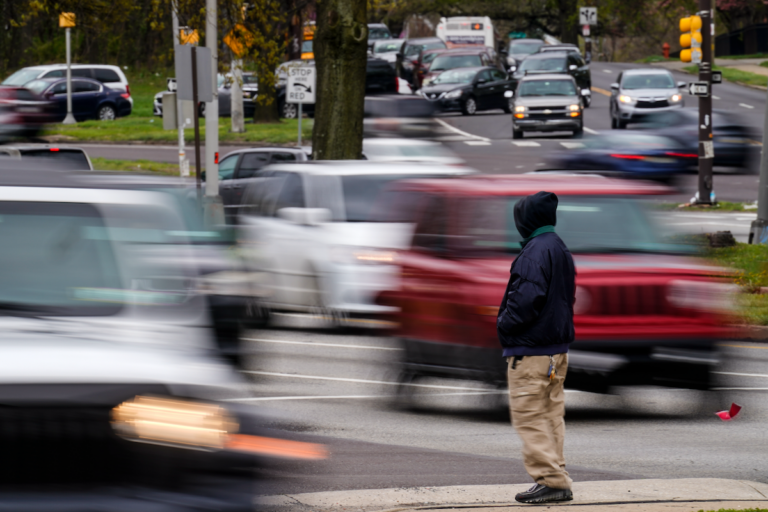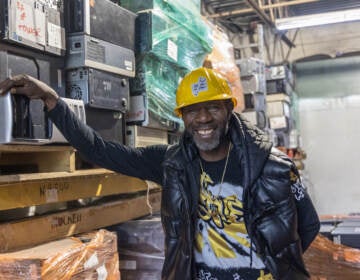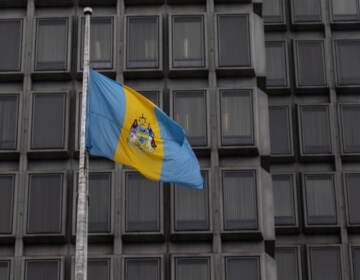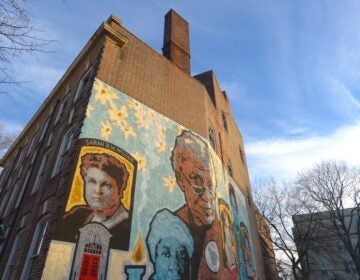With PennDOT studying transit options for Roosevelt Boulevard, a subway is back on the table
PennDOT has committed to studying transit options on Roosevelt Blvd. This means that Philly is one step closer to a new subway line, writes doctoral student Jay Arzu.

A pedestrian waits to cross Roosevelt Boulevard, in Philadelphia, Tuesday, April 19, 2022. (AP Photo/Matt Rourke)
The momentum to finally build the Roosevelt Boulevard subway continues as residents from Northeast Philadelphia and across the city met once again in October for a second community workshop. The gathering was an opportunity for residents to communicate with state and city agencies about the long-term future of transportation on the corridor and ended with hopeful news.
While the SEPTA and city representatives seemed focused on near-term solutions like creating bus lanes on the boulevard, a PennDOT engineer informed the audience that the second phase of PennDOT’s Route for Change would begin in a few weeks and that a subway alternative would be studied alongside other transit modes like Bus Rapid Transit (BRT) and Enhanced Bus and Light Rail Transit (LRT).
It was a stunning moment for many in the room because it has been over 20 years since a subway alternative was studied for Roosevelt Boulevard.
Opening the door to possibilities
For the last 20 years, SEPTA’s and PennDOT’s focus has been on enhancing bus service with the long-term goal of dedicated lanes in Roosevelt Boulevard’s median in a similar fashion to the BRT systems in South American cities like Bogota, Colombia and Curitiba, Brazil.
PennDOT’s decision to pursue a study does not mean that the subway is a guarantee, but opens the door to discussions on the future of the corridor.
PennDOT will have multiple transit options, and they will have to study them equally to qualify for future federal funding. The problem with recent studies like the one PennDOT is launching is that subway alternatives are usually “sandbagged,” meaning that the project costs are inflated to defeat the subway proposal before the public gets to weigh in on which one they prefer.
We all know that subways are expensive to build, but comparing the cost of building a Roosevelt Boulevard subway to the first phase of the Second Avenue subway in New York City isn’t a fair comparison. We will only know the cost of the subway alternative when HNTB, the engineering company serving as PennDOT’s study lead, finishes their initial assessment. Policymakers and bureaucrats should not “guestimate” how much the project could cost because it could risk tanking the subway plan.
A significant risk with the subway alternative is what form of construction is being studied.
Roosevelt Boulevard’s median is wide enough for cut-and-cover subway construction that could be done much cheaper than if we used a tunnel boring machine like New York City did for its Second Avenue subway extension. Paying close attention to how PennDOT and HNTB develop the subway alternative is essential.
Many at the workshop wanted two subway alternatives for the study: a cut-and-cover subway that transitions into an elevated viaduct in the Far Northeast and another one where most of the subway line would operate on a viaduct similar to the elevated sections of the Washington Metro. Public participation and engagement must be robust for anything to be built on Roosevelt Boulevard. The Northeast Philadelphia community will have to come to Route for Change meetings and be unified in their ask for the long proposed subway, just like generations before them did in the 1960s and early 2000s.
Money and momentum can move the project forward
If a subway alternative is chosen, funding it won’t be easy. Still, with recently passed legislation and discretionary grants, it is more possible today to build the Roosevelt Boulevard subway than when Philadelphia last tried in 2003. The most significant challenge will be getting a local match for federal dollars. We will need policymakers in Harrisburg and City Hall to come together, which makes it remarkable that state Rep. Jared Solomon has been a champion for getting the subway done.
At the federal level, we need Congressman Brendan Boyle to be a champion. He has thus far been silent on the project, but with his support in Washington, discretionary grants like the RAISE grants — funds to help modernize transportation — could help supplement funding for the subway.
The timing of this project is ideal because funding opportunities continue to come from the U.S Department of Transportation (USDOT). For example, the Inflation Reduction Act includes the neighborhood Access and Equity Grants program. This program contains $3 billion that can be used to redesign overbuilt arterial roads like Roosevelt Boulevard, to make it more accessible for various modes of transportation — like a potential subway and bicycles.
A new program called TIFIA 49 was released through the USDOT’S Build America Bureau. TIFIA 49 creates a new low-cost financing system for transit projects like the Roosevelt Boulevard subway. It also authorizes borrowing up to 49% of project costs. Projects that construct or improve public transportation infrastructure — like subways — are eligible for this grant. Simply put, if this program had existed when the subway was last proposed in 2003, it would have made it affordable enough to construct.
Looking toward the future, some remain skeptical of the Roosevelt Boulevard subway ever being built, but the momentum behind the subway has shown that if a community comes together with stakeholders and elected officials with a solid plan, anything is possible.
The Roosevelt Boulevard subway is back on the table.
Jay Arzu is a doctoral student of City and Regional Planning at the University of Pennsylvania Stuart Weitzman School of Design.

Subscribe to PlanPhilly
WHYY is your source for fact-based, in-depth journalism and information. As a nonprofit organization, we rely on financial support from readers like you. Please give today.








